
ARTIFICIAL INTELLIGENCE,
ROBOTS, AND SUFISM

For sometime now, I have been saying that contents of a Sufic nature are spontaneously emerging into Western culture. This is perhaps best exemplified in the imagined step from an artificially intelligent robot to a human being.

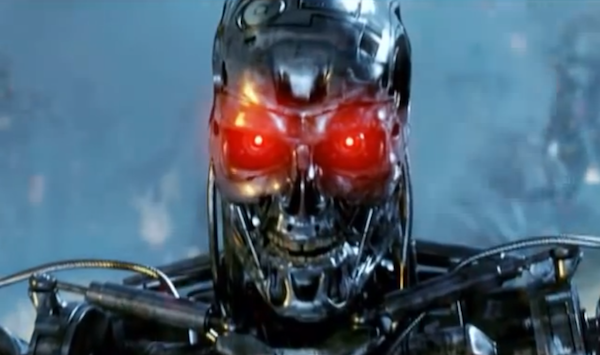 A spate of new movies and TV series has given expression to the (sometimes bizarre!) humanization of automatons. Among them are I, Robot (2004) (originating with the famous science fiction writer Isaac Asimov) and Ex Machina (2015). A man falls in love with the seductive voice of his cell phone’s operating system in Her (2013). We already have disturbingly lifelike humanoid robots (see this): what will happen in a decade or two? They’re called Mecha in Spielberg’s A.I. (2001), Cyborgs in the Terminator films and TV series, Mechanids in Extant (TV), Androids in Almost Human (TV), Dark Matter (TV) and Westworld (movies and TV series), and Synths in the British Humans (TV). Whatever name they’re called by, the result is always the same: the robots take on increasingly human characteristics, while in at least some cases, humans become progressively more robot-like. In James Cameron’s rightfully famous Terminator 2 (1991), the movie ends with the words: “if a machine ... can learn the value of human life, maybe we can too.” Others view the rise of the robots with alarm. Physicist Stephen Hawking is on record as saying: “The development of full artificial intelligence could spell the end of the human race.”
A spate of new movies and TV series has given expression to the (sometimes bizarre!) humanization of automatons. Among them are I, Robot (2004) (originating with the famous science fiction writer Isaac Asimov) and Ex Machina (2015). A man falls in love with the seductive voice of his cell phone’s operating system in Her (2013). We already have disturbingly lifelike humanoid robots (see this): what will happen in a decade or two? They’re called Mecha in Spielberg’s A.I. (2001), Cyborgs in the Terminator films and TV series, Mechanids in Extant (TV), Androids in Almost Human (TV), Dark Matter (TV) and Westworld (movies and TV series), and Synths in the British Humans (TV). Whatever name they’re called by, the result is always the same: the robots take on increasingly human characteristics, while in at least some cases, humans become progressively more robot-like. In James Cameron’s rightfully famous Terminator 2 (1991), the movie ends with the words: “if a machine ... can learn the value of human life, maybe we can too.” Others view the rise of the robots with alarm. Physicist Stephen Hawking is on record as saying: “The development of full artificial intelligence could spell the end of the human race.”
(Perhaps, if we are able to program our robots with Islamic ethics, we will be able to avoid killer robots for a while longer. Otherwise...)
The word “robot” itself was coined by Karel Capek in his 1921 play R.U.R., short for “Rossum’s Universal Robots.” The tale of Pinocchio (1883, 1940) describes a wooden puppet that becomes a human being. We can trace the concept further back to Mary Shelley’s Frankenstein (1818), and even earlier, to the Kaballistic concept of the Golem, a clay effigy that is animated by placing a piece of paper bearing a name of God or a sacred formula in its mouth. The earliest attribution of the creation of a golem by a historical figure dates from 1630 or later, while the earliest known written account of how to create a golem goes back to the 12th-13th centuries. From there, it is lost to history, though imaginative people have probably dreamed of mechanical slaves to free themselves of toil from time immemorial. Disney’s version of The Sorcerer’s Apprentice had the young upstart animating brooms by magic to do the cleaning, until things went awry.
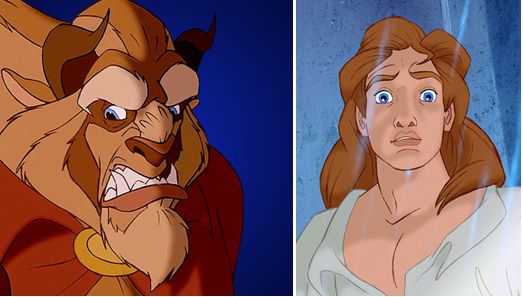 |
|
Before After |
Closely related, it would seem, are the themes of a beast turning into a human being (Disney’s Beauty and the Beast (1991)), and the achievement of human-level intelligence by apes (the Planet of the Apes series of movies and reboots).
We have seen computers encroaching on areas hitherto deemed exclusive to human beings. IBM’s Deep Blue bested chess master Garry Kasparov in 1997. More recently (2016), Google’s DeepMind unit has defeated the world champion of Go.
Science fiction writer Vernor Vinge was the first to popularize the notion of a “technological singularity,” or “Singularity” for short, in the 1990s (the term was first used by mathematician John von Neumann in 1958). In this conception, an artificial superintelligence (ASI) triggers runaway technological growth, leaving humanity in the dust. A machine would be able to design one more intelligent than itself, in a process that would last an indeterminate number of steps. At some stage, machine intelligence would surpass all human intelligence, and future evolution would take place in the mechanical, not human, realm. This would be a posthuman future. (It seems as if they’re trying to say “God,” but can’t quite bring themselves to say it.)
Is this what is in store for us? Are humans to be supplanted by machines, their creations? Or does man’s possible evolution encompass entirely different transhuman possibilities, leading to the realization of a Universal Human or Perfect Human Being (insan al-kâmil), as envisaged by Sufism? (This would be a human Singularity, not a technological one.)
According to the Sufi masters, we already possess the potential to evolve into something higher that no machine evolution could ever equal, even if machines and humans were to be integrated as cybernetic organisms (cyborgs). (This includes bionic wo/men and supersoldiers.)
Conscious Machines?
Along with ever-increasing machine intelligence, there is a tendency to assume the existence of machine consciousness. (Human beings are very good at idolizing, or at least anthropomorphizing, what they make with their own hands.) The aforementioned movies and TV series dwell upon this to one extent or other, introducing automatons that seem to act consciously, just like human beings.
Is this even possible? Can there be such a thing as machine consciousness, an electronic circuit that is self-aware, if it is complicated enough?
While the idea of machine consciousness has its proponents, it also has its skeptics. Professor of philosophy John Searle is one of the latter. According to his “Chinese room” argument, no program can give a computer a mind, understanding or consciousness, no matter how human-like the computer may appear to behave. Although he is a naturalist, Searle has argued that the brain is not a computer and that a computer program does not explain consciousness. He says that consciousness is a biological phenomenon produced by the brain, while “the programmed computer understands what the car and the adding machine understand, namely, exactly nothing.”
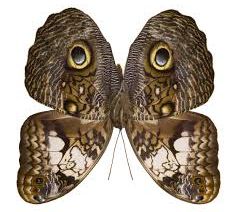 |
|
Mimicry in nature. |
Alan Turing famously described a test for intelligence in a computer. According to the dictionary, the Turing test requires that “a human being should be unable to distinguish the machine from another human being by using the replies to questions put to both.” While this may seem plausible, it does not imply sameness. Also, this is a test for intelligence, not consciousness. IBM’s Deep Blue is not a chess master, even if it beat Kasparov, and it does not think like one. It achieved superiority by making trillions of calculations in a short time. We cannot program a computer to think like a chess master, first of all because we do not know how the mind of a chess master works (we do know it’s not by brute force). Mimicry is not identity: a simulation is not the real thing, any more than a dream is reality. Or, as Alan Watts used to say, the map is not the territory, and we should not confuse the two.
As the editors of IEEE Spectrum noted in their “Singularity” special issue:
“we’re still a very long way from understanding how consciousness arises in the human brain, let alone figuring out how to re-create it in a machine. We’re even a long way from the much simpler goal of creating autonomous, self-organizing, and perhaps even self-replicating machines.”
Hitting a Brick Wall
Three decades before that quote, Nobel-Prize-winning neurophysiologist David Hubel wrote: “Our knowledge of the brain is in a very primitive state. While for some regions we have developed some kind of functional concept, there are others, the size of one’s fist, of which it can almost be said that we are in the same state of knowledge as we were with regard to the heart before we realised that it pumped blood.” (quoted here.)
Despite great strides in neuroscience since then, little has changed. Philosopher Colin McGinn has declared the problem of consciousness unsolvable. Edward Witten, referred to as one of the world’s smartest physicists, has called it a mystery. Just recently, science writer John Horgan, an astute observer of the field of consciousness research, has noted “signs of desperation” in the plethora of theories that have been proliferating.
Such theories fall short because, to recall the famous Nasruddin Hodja joke, they're looking for the key in the wrong place. Occam’s Razor dictates the simplest solution: the so-called “hard” problem of consciousness is not going to be cracked within the realm of physics. The brain is an interface between the mind and the physical world, and the body-brain complex is an interface between the spirit and the sensory world. (To draw a crude analogy, spirit is like “software” downloaded onto our physical hardware.) Naturally, any impairment in the interfaces interferes with the full functioning of both. As soon as you factor spirit into your calculations, the problem evaporates.
The Prophet said: “Knowledge is twofold: first, the knowledge of bodies [i.e. the physical], and then the knowledge of religions [the spiritual].” Our present-day knowledge, then, actually constitutes half of what it ought to be. For in its sadly deficient state, modern science does not recognize the existence of a spirit. Yet consciousness and self-awareness are functions of this entity. You would need to “in-spirit” (our word “inspire” comes from this) or “ensoul” a machine before it could become conscious, and for self-awareness, even this is not enough: you would need a specifically human spirit. And for this, in turn, you need a locus capable of accepting it—in other words, an organic substrate. Nor, finally, will any organic infrastructure do: you need a human body.
So while all our incredible efforts may be able to achieve robots indistinguishable from human beings, we have no grounds to expect that they will be aware or self-conscious. What is happening, rather, is that programmers are encoding human-like responses into their software. These are testimony more to the ingenuity of their coders than to their own intelligence. There’s no use searching for that magical piece of code that you upload and—Presto!—a robot suddenly becomes conscious, because it doesn’t exist. To pin one’s hopes on sufficient complexity is wishful thinking.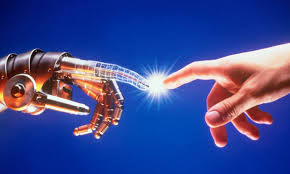
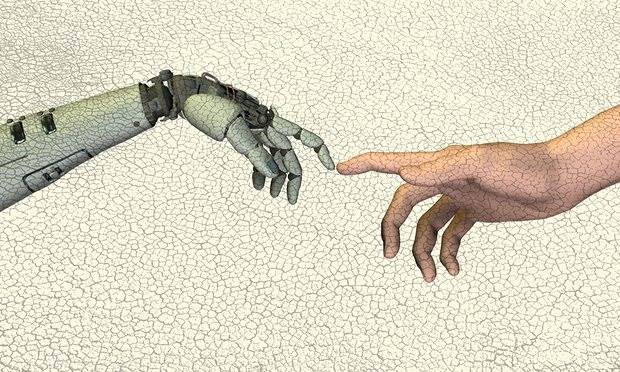 As Master Ahmet Kayhan observed, “The computer emerged from man, not vice versa.” This shows that man is superior.
As Master Ahmet Kayhan observed, “The computer emerged from man, not vice versa.” This shows that man is superior.
While the hubristic goal of creating a human being (like God did!) may be unachievable, however (except by the perennial method of procreation), such notions do have Sufic relevance. For all such conceptions—creating conscious robots, turning an animal into a human being, or a puppet into a real boy—are metaphors or allegories for transforming the “only human” into the Perfect Human.
Mechanical Man
George Gurdjieff (flourished circa 1920-50), some parts of whose teachings were borrowed heavily from Sufism, used to call human beings in their ordinary state “mechanical man” or “machine-man.” By this, he did not mean that humans were composed entirely of matter, as a materialistic worldview would require, along the lines of La Mettrie’s L’homme machine (“Machine Man” or “The Human Mechanism,” 1748). Rather, he meant that a person always responds in the same way to a certain kind of stimulus. Today, we would say that such human beings are bound by their conditioning or programming. In his view, mechanical man was in “the prison of himself.”
In more precise Sufic terms, such a person is in the prison of his Base Self. One has to cast off the shackles of the Base Self if one wishes to get anywhere. Instead of being a slave to the Base Self, one should make the Base Self one’s slave. And that is no easy task: it requires much struggle, much work on oneself.
Peter Ouspensky, a student of Gurdjieff, put it as follows:
What does it mean that man is a machine?
It means that he has no independent movements, inside or outside of himself. He is a machine which is brought into motion by external influences and external impacts. All his movements, actions, words, ideas, emotions, moods and thoughts are produced by external influences. By himself, he is just an automaton...
Man cannot move, think or speak of his own accord. He is a marionette pulled here and there by invisible strings. If he understands this, he can learn more about himself, and possibly then things may begin to change for him...
Man is a machine, but... he may find the ways to cease to be a machine.
(The Psychology of Man’s Possible Evolution (1949).)
The Journey Inwards
Following Gurdjieff, Ouspensky linked human mechanicalness with consciousness—or rather, the lack thereof.
... the state in which we are now, that is, in which we work, talk, imagine ourselves conscious beings, and so forth, we often call ‘waking consciousness’ or ‘clear consciousness’ but really it should be called ‘waking sleep’... (Ibid.)
And Idries Shah begins his famous study, The Sufis (1964), with the fable of the Islanders, about a people who are asleep even when they are awake. This all derives from the Prophet’s own words: “Human beings are asleep, they wake up when they die.”
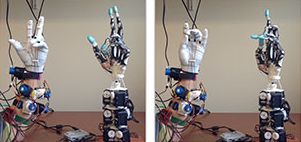
According to Gurdjieff, “The evolution of man is the evolution of his consciousness.” Also: “Evolution is the result of conscious struggle.”
(Ouspensky, In Search of the Miraculous (1949).)
Hence, consciousness is the very opposite of mechanicalness—of dead matter. (One should also mention here British author Colin Wilson’s concept of the robot: as Michael Dirda has summarized it, “we sleepwalk through much of our lives, relying on an internalized robot self that automatically attends to our routine tasks and ignores the richness and wonder around us. The more we rely on the robot, the less authentic we feel.”)
And since consciousness is a property of the spirit, what we are talking about here is a spiritual, as well as psychological, transformation (where “psyche” means the self). The Sufis have identified seven stages in the development of the self, the lowest of which we have already encountered: the Base Self. (Modern psychology is almost wholly concerned with the latter.)
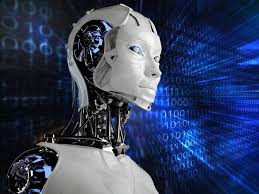 Some have argued that Sufism leads to narcissism. It has been claimed, for example, that “There is no Other in Sufism, only your own ego grinning back from the universe.” Nothing could be further from the truth. This is to radically misunderstand some of the most basic concepts of Sufism. The difference between our little, local self (the Base Self: nafs al-ammâra) and the Self of the Universe (the Total Self: nafs al-kull) is far vaster than the difference between a puddle and an ocean. Not self-love, but the love of God, gets us there. Otherwise, you remain in the prison of your Base Self.
Some have argued that Sufism leads to narcissism. It has been claimed, for example, that “There is no Other in Sufism, only your own ego grinning back from the universe.” Nothing could be further from the truth. This is to radically misunderstand some of the most basic concepts of Sufism. The difference between our little, local self (the Base Self: nafs al-ammâra) and the Self of the Universe (the Total Self: nafs al-kull) is far vaster than the difference between a puddle and an ocean. Not self-love, but the love of God, gets us there. Otherwise, you remain in the prison of your Base Self.
The “Other” Within
To use sociologist David Riesman’s term, human beings are “other-directed,” as opposed to inner-directed. The Base Self too is an “other,” even if it is within us—it is not our essential core. In fact, it is what keeps us from realizing our true Essence.
This means: you yourself are the greatest obstacle to your progress. Your Base Self is the curtain that veils your inner, better self. And for this reason, the Sufis have said:
You get out from in between
And the Creator at once is seen.
They also pray (with the Turkish Sufi poet Yunus Emre):
Remove me-ness from me
With you-ness fill me.
Immoral actions, however, cause the Base Self to become so entrenched that you can never get rid of it. And paramount among these are Illicit Gain and Illicit Sex.
But if we are puppets of our Base Self, we could do worse than consider the cautionary tale of Pinocchio.
This subject merits a separate article in and of itself.